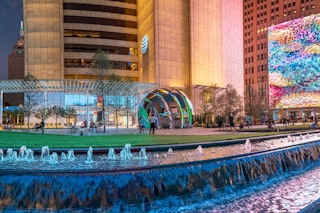On Air and on Stage Through Every Age
A brief history of Dallas music.
From raucous shows at the historic Kessler Theater to the rise of Deep Ellum and every local chart topper in between, the history of Dallas music shows how a city has flourished alongside its rising, innovative artists.
While the city's early history is steeped in blues and the giants who made it, Dallas is a city that has always embraced a diverse array of artists.
Part of that is embedded in the city's DNA. Everything from soulful blues to sultry country and praiseworthy punk has taken center stage in Dallas at one time or another--a fact that speaks to the city's malleability, versatility and hospitality as a home for artists. While the sounds may have changes and venues may have come and gone, Dallas' music history is the story of a city that continues to house some of the most creative creators in the music world today.
The Rise of an Era
In the early 1870s, a brand-new business district rose around a railroad crossing just east of Dallas. The area was called Deep Ellum: "Deep" because of its distance from the courthouse square, and "Ellum" because of the way its original residents pronounced "Elm." Theatres like the now famous Majestic housed popular vaudeville shows, while musicians like Alex Moore, Buster Smith, Huddie "Lead Belly" Ledbetter and Blind Willie Johnson blazed trails for blues artists in Dallas and beyond.
In 1925, soon-to-be Deep Ellum legend Blind Lemon Jefferson became one of the first blues musician to record his music. Soon after, the Shelton Brothers came to Deep Ellum to record the first of many "Deep Ellum Blues." The 1930s saw the arrival of Western swing and hot fiddle bands, with Bob Wills and Roy Newman not far behind. Many of the musicians that followed were heavily influenced by the blues innovators of Deep Ellum's 1920s era, and while the area went into decline with the Great Depression, this business district by the railroad was destined to rise and reclaim its status as a neighborhood made by and for diverse artists.
A Rock Revolution
When it returned to prominence in the 1970s, it was punk rock that took center stage. But the blues roots are still noticeable in Deep Ellum and elsewhere throughout the city, and Dallas at large never lost that unique, soulful sound that it became known for after the turn of the century. Ledbetter, Johnson and T-Bone Walker led to Freddie King, Robert Johnson, and eventually, Stevie Ray Vaughan. In turn, these trailblazers inspired the next generations of Dallas artists, whether they sang the blues, shredded a guitar or crafted flawless rhymes.
Looking Forward
As the clock turned toward another century, with the Texas Playboys becoming The Texas Gentlemen, Dallas became a home for hip-hop and country stars alike. At the same time, radio stations like KZEW (aka "The Zoo") and venues like The Granada Theatre provided a home for innovative soul-stirrers and songstresses from every genre imaginable.
When the Sex Pistols came across the pond for their first and only tour of the States, they made Dallas their sole Texas stop in what would become a raucous and infamous night at The Longhorn Ballroom. That venue's recent revival is a testament to the grit and resilience of Dallas' artists and art scene. As venues continue to rise in Deep Ellum and Oak Cliff, Dallas continues to be a home for musicians of all kinds and the producers, promoters, writers, roadies and fans who will propel the city through the next century and beyond.













